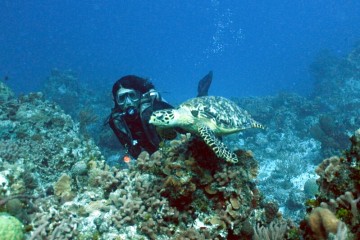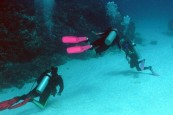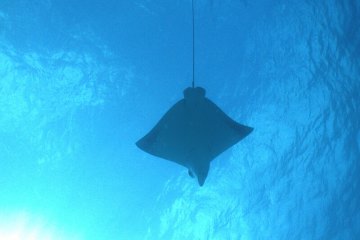If you look for it, you’ll be able to find a ton of information on diving in Cozumel. Given its position as the most popular dive destination in North America, every dive shop in America has books and maps describing diving here. But a large part of the resource of information (both accurate and bad) is not found on a printed page but rather in various forms all over the Internet. With every new diver that visits there every year, another view of Cozumel as a general dive destination and of specific dive sites seems to be added to the pile of opinions. As someone who has made countless trips to the island and who has accumulated over 700 dives there, I know there is still a lot that I don’t know about diving Cozumel. And I know a lot of what I read on the net describing diving there is drivel.
So I take it with a grain of salt when people who have spent one week diving in Cozumel and made perhaps 6 or 8 dives or even worse, someone who has taken a dive excursion off of a cruise ship feel they have enough information to form an opinion of diving in Cozumel and post it on some internet scuba message board as some great revelation.
The following discussion has been created over a number of years from notes and logs recorded while enjoying those 700 dives. It represents honest, unbiased personal judgment. There may be some who might disagree with some of what follows but it does represent an educated opinion.
While one of the great joys of diving in Cozumel is the variety of sites and conditions, there are several characteristics that most dives in the resort diving area share. As might be expected, exceptions to all of the following will be found.
Unless there is a storm approaching, the prevailing current runs south to north (if facing the island from the boat, from right to left) at most dive sites. This constant river-like flow supplies the reef system with both the nourishment and the cleansing essential for lush coral, extended visibility and a healthy fish population. Depending on the weather, the topography and location of the specific site, the flow can range from barely perceptible to ripping. More than one diver has come up comparing a Cozumel drift dive to the dream sensation of flying.
Because of this stream, virtually all dives are drift dives meaning that the boat will not anchor but will follow the current. The captain, using his knowledge of the reef structure and the typical time it takes to run it and keeping an eye on divers’ bubbles will usually be waiting for you when you return to the surface. Divers rarely fight the current, but rather find their proper depth, relax and let the flow carry them along. On dives with little or no current a diver will occasionally kick their fins but on some others, will primarily use flippers for directional changes only.
The most common underwater landscape generally begins nearest the island with a relatively shallow (30 to 60 feet) sandy bottom. The first set of structures is the shallow coral reefs that can reach within a few feet of the surface. These will give way to the deeper coral that can rise from over 100 feet. And finally, comes “The Wall” which drops off to a depth of thousands of feet. There usually is a second sandy bottom between the shallow and the deep coral or, sometimes, valleys of sand between two ridges of coral.
The typical two-tank dive trip begins with a boat ride to the south of the hotel district. Most dive operators have a main pier they ask divers to meet at but, if asked, are willing to pick up at hotel piers on the way out. The “fast boats” can reach some sites in 15 minutes and take approximately 45 minutes to the southernmost dive points. The slow boats can take up to twice as long. Unless a special deeper dive has been arranged, the first dive will generally run 75 to 90 feet. After an appropriate surface interval, which will include a boat ride back north towards the hotel district, this is followed by a shallow dive of usually 40 to 60 feet. If asked, fast boat captains are usually willing to spend part of the surface interval on a beach. The fact that operators prefer to make the second dive on the way back from the first dive (and thus reduce the length of the boat ride home after the second dive) can limit the opportunity to dive some of the southern shallow reefs.
The dive master will share any tips with the crew. While divers are not obligated to tip, $5 per day per diver is appropriate for good service.
All beaches and dive sites from the ferry pier in downtown San Miguel to the southern tip of the island are protected as a part of an underwater national park. No fishing is allowed in this area and divers are not allowed to keep any souvenirs, not even the smallest shell. Fishing and shell collecting are allowed north of the downtown pier and on the ocean side of the island.
Water visibility on most Cozumel reefs usually averages between 100 and 150 feet. This will be reduced during the rainy season (June-October) but even then, because of the absence of any above ground rivers or streams on the island, 75 or more feet is the norm.
Water temperature is relatively constant year round with a range of the upper 70′s in the winter to the lower 80′s in the summer. Divers that are sensitive to the cold may opt for a 1/8″ or 3mm wet suit, shorty or jacket but many divers are comfortable in a dive skin only.



